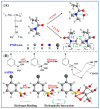Controlled Release of Insulin Based on Temperature and Glucose Dual Responsive Biomicrocapsules
- PMID: 35268787
- PMCID: PMC8912095
- DOI: 10.3390/molecules27051686
Controlled Release of Insulin Based on Temperature and Glucose Dual Responsive Biomicrocapsules
Abstract
The treatment of diabetes lies in developing novel functional carriers, which are expected to have the unique capability of monitoring blood glucose levels continuously and dispensing insulin correctly and timely. Hence, this study is proposing to create a smart self-regulated insulin delivery system according to changes in glucose concentration. Temperature and glucose dual responsive copolymer microcapsules bearing N-isopropylacrylamide and 3-acrylamidophenylboronic acid as main components were developed by bottom-spray coating technology and template method. The insulinoma β-TC6 cells were trapped in the copolymer microcapsules by use of temperature sensitivity, and then growth, proliferation, and glucose-responsive insulin secretion of microencapsulated cells were successively monitored. The copolymer microcapsules showed favorable structural stability and good biocompatibility against β-TC6 cells. Compared with free cells, the biomicrocapsules presented a more effective and safer glucose-dependent insulin release behavior. The bioactivity of secreted and released insulin did not differ between free and encapsulated β-TC6 cells. The results demonstrated that the copolymer microcapsules had a positive effect on real-time sensing of glucose and precise controlled release of insulin. The intelligent drug delivery system is supposed to mimic insulin secretion in a physiological manner, and further provide new perspectives and technical support for the development of artificial pancreas.
Keywords: copolymer microcapsule; fluidized bed reactor; insulin delivery system; insulinoma β-TC6 cells; poly(N-isopropylacrylamide).
Conflict of interest statement
The authors declare no conflict of interest.
Figures











Similar articles
-
An intelligent multicompartmental system based on thermo-sensitive starch microspheres for temperature-controlled release of drugs.Biomed Microdevices. 2010 Aug;12(4):693-704. doi: 10.1007/s10544-010-9422-5. Biomed Microdevices. 2010. PMID: 20414809
-
Glucose-Sensitive Nanoparticles Based On Poly(3-Acrylamidophenylboronic Acid-Block-N-Vinylcaprolactam) For Insulin Delivery.Int J Nanomedicine. 2019 Oct 4;14:8059-8072. doi: 10.2147/IJN.S220936. eCollection 2019. Int J Nanomedicine. 2019. PMID: 31632018 Free PMC article.
-
Glucose-responsive microgels with a core-shell structure.J Colloid Interface Sci. 2008 Nov 15;327(2):316-23. doi: 10.1016/j.jcis.2008.08.039. Epub 2008 Aug 28. J Colloid Interface Sci. 2008. PMID: 18804779
-
Advances in phenylboronic acid-based closed-loop smart drug delivery system for diabetic therapy.J Control Release. 2019 Jul 10;305:50-64. doi: 10.1016/j.jconrel.2019.05.029. Epub 2019 May 18. J Control Release. 2019. PMID: 31112719 Review.
-
[Design of nanohydrogel-incorporated microcapsules for appropriate controlled-release of peptide drugs].Yakugaku Zasshi. 2007 May;127(5):813-23. doi: 10.1248/yakushi.127.813. Yakugaku Zasshi. 2007. PMID: 17473523 Review. Japanese.
Cited by
-
Inhibition of miR-146a-5p and miR-8114 in Insulin-Secreting Cells Contributes to the Protection of Melatonin against Stearic Acid-Induced Cellular Senescence by Targeting Mafa.Endocrinol Metab (Seoul). 2022 Dec;37(6):901-917. doi: 10.3803/EnM.2022.1565. Epub 2022 Dec 7. Endocrinol Metab (Seoul). 2022. PMID: 36475359 Free PMC article.
-
Electroresponsive Thiol-Yne Click-Hydrogels for Insulin Smart Delivery: Tackling Sustained Release and Leakage Control.ACS Appl Polym Mater. 2024 Jul 11;6(14):8093-8104. doi: 10.1021/acsapm.4c00911. eCollection 2024 Jul 26. ACS Appl Polym Mater. 2024. PMID: 39839886 Free PMC article.
References
-
- Zou H., Wang C.Y., Yuan W.Z., Wang S.F., Li M.Q. Functional micelles formed from glucose-, thermo- and pH-triple responsive copolymers for controlled release. Polym. Chem. 2017;8:4869–4877. doi: 10.1039/C7PY01093A. - DOI
-
- Tang Z., Guan Y., Zhang Y.J. The synthesis of a contraction-type glucose-sensitive microgel working at physiological temperature guided by a new glucose-sensing mechanism. Polym. Chem. 2018;9:1012–1021. doi: 10.1039/C8PY00072G. - DOI
-
- Hu D.N., Ju X.J., Pu X.Q., Xie R., Wang W., Liu Z., Chu L.Y. Injectable temperature/glucose dual-responsive hydrogels for controlled release of insulin. Ind. Eng. Chem. Res. 2021;60:8147–8158. doi: 10.1021/acs.iecr.1c01277. - DOI
-
- Kataoka K., Miyazaki H., Bunya M., Okano T., Sakurai Y. Totally synthetic polymer gels responding to external glucose concentration: Their preparation and application to on-off regulation of insulin release. J. Am. Chem. Soc. 1998;120:12694–12695. doi: 10.1021/ja982975d. - DOI
MeSH terms
Substances
Grants and funding
LinkOut - more resources
Full Text Sources
Medical

